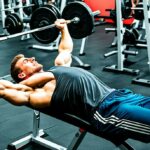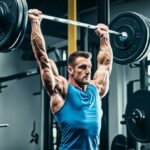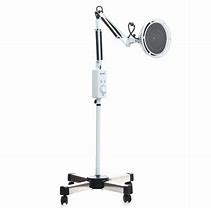Last Updated on 3 months by Francis
Welcome to our article on the incline to flat bench ratio and how it can help optimize your lifts. If you’re familiar with bench pressing, you know that it’s an essential exercise for building chest and shoulder muscles. However, did you know that there’s a specific ratio between incline bench presses and flat bench presses that can enhance your workout routine and maximize your muscle development?
The incline bench press and the flat bench press are both effective chest exercises commonly used in strength training and bodybuilding. While they target the same major muscle groups, there are distinct differences between the two. The incline bench press emphasizes the upper chest more, while the flat bench press works the entire chest.
Studies have shown that an incline of approximately 30 degrees is optimal for targeting the upper chest during the incline bench press. This angle stimulates muscle growth in the upper pecs and activates the anterior deltoids (front delts) to a greater extent. Understanding the incline to flat bench ratio is crucial for achieving balanced muscle development and optimizing your lifts.
Contents
Key Takeaways:
- The incline bench press focuses on the upper chest, while the flat bench press works the entire chest.
- An incline of around 30 degrees maximizes upper chest activation during the incline bench press.
- Most people are stronger in the flat bench press compared to the incline bench press.
- Optimizing the incline to flat bench ratio is important for balanced chest muscle development.
- Incorporating both incline and flat bench presses into your workout routine can enhance your overall strength training and muscle growth.
Differences between Incline and Flat Bench Presses
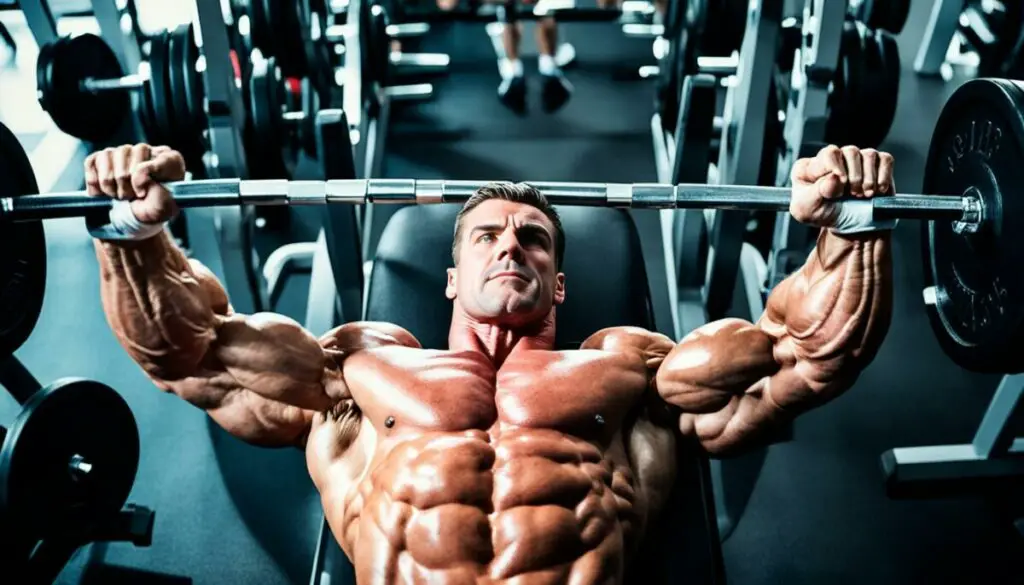
The incline bench press and the flat bench press have several key differences. Let’s take a closer look at each exercise:
Incline Bench Press
The incline bench press primarily targets the upper chest, activating the muscles in that region. This exercise is performed on a bench set at an incline angle, usually around 30 degrees. In addition to targeting the upper chest, the incline bench press also engages the anterior deltoids (front delts) to a greater extent. This exercise can be an effective way to develop the upper chest and the front delts.
Flat Bench Press
The flat bench press, on the other hand, works the entire chest, including the upper, middle, and lower pecs. This exercise is typically performed on a flat bench, allowing for a greater range of motion compared to the incline bench press. The flat bench press is a fundamental chest exercise that serves as a cornerstone for overall chest development. It also engages other muscles such as the triceps and shoulders.
While both exercises contribute to muscle growth and development, they target different areas of the chest and activate the muscles in varying degrees.
Studies have shown that training only incline bench presses can lead to significant growth in the upper pecs, while the flat bench press provides a more comprehensive chest workout. It’s important to find the right balance between incline and flat bench presses to achieve optimal chest muscle development.
Best Angle for Incline Bench Pressing
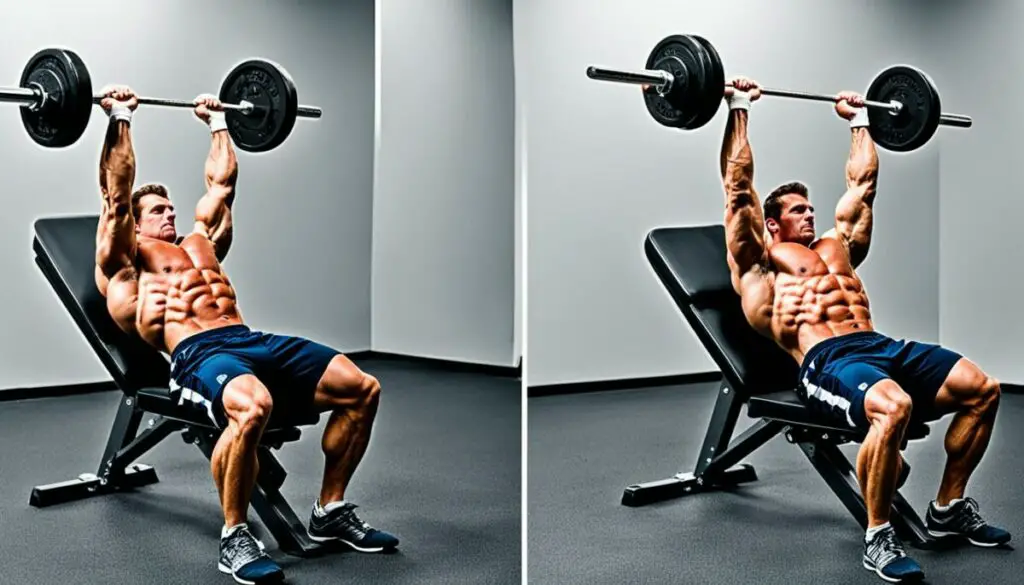
When it comes to incline bench pressing, finding the best angle is crucial for maximizing upper pec activation and optimizing your shoulder exercise. Research suggests that an incline angle of around 30 degrees is ideal for targeting the upper pecs while minimizing stress on the shoulder joint.
Going higher in inclination, such as 45 or 60 degrees, may decrease upper pec activation and shift the focus more towards shoulder engagement rather than chest development. Therefore, it’s important to stick to the recommended angle to achieve the desired results.
If you’re working out on an adjustable training bench, you can usually achieve a 30-degree inclination by using the first or second setting above horizontal. This will help you maintain the proper bench angle needed for optimal upper pec activation.
Remember, the most important thing is to feel your upper pecs working during the exercise, regardless of the specific angle you use. Listen to your body, experiment with different inclinations if necessary, and find the angle that allows you to effectively target your upper chest muscles.
| Incline Angle | Upper Pec Activation | Shoulder Engagement |
|---|---|---|
| 30 degrees | Significantly higher | Minimal |
| 45 degrees | Decreased | Increased |
| 60 degrees | Further decreased | Increased |
By maintaining the correct bench angle for incline bench pressing, you can ensure optimal upper pec activation and target your chest muscles effectively during your shoulder exercise.
How Incline Bench Press Improves Flat Bench Press
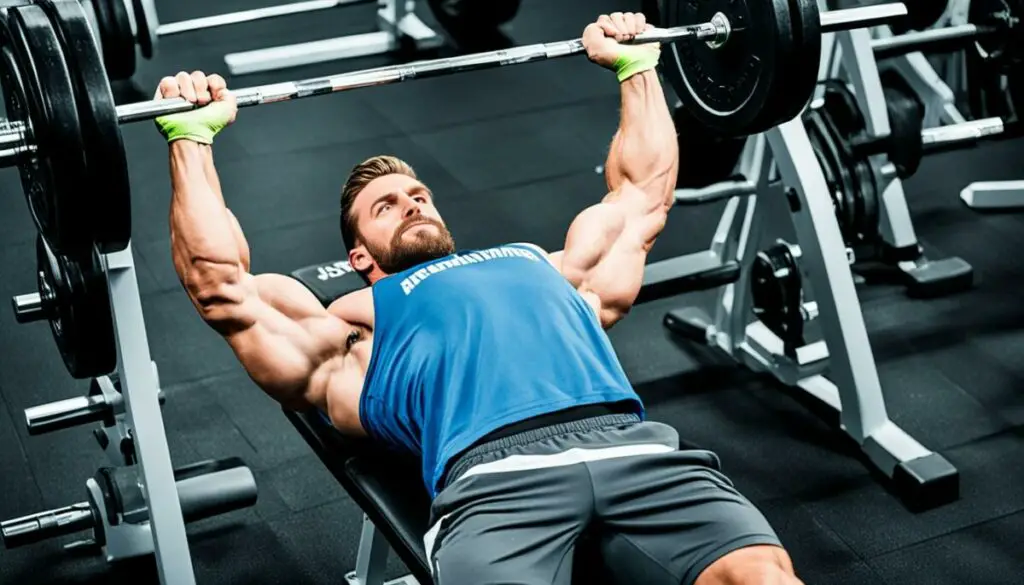
The incline bench press exercise can have a positive impact on your flat bench press and overall chest muscle development. By incorporating incline bench presses into your workout routine, you can target your upper chest and anterior deltoids more effectively. This targeted stimulation can lead to increased strength and muscle development, enhancing your performance in any exercise that utilizes these muscle groups.
It’s important to note that the flat bench press remains crucial for overall chest development. This exercise works the entire chest, including the lower pecs, providing a well-rounded approach to chest muscle growth. By combining both incline and flat bench presses in your training regimen, you can achieve balanced chest development and maximize your overall results.
So, why does the incline bench press improve the flat bench press? The answer lies in the specific muscle groups that each exercise targets. The incline bench press primarily focuses on the upper chest and anterior deltoids, which are key muscles involved in pressing motions. By strengthening these specific muscles through incline bench pressing, you can increase their strength and efficiency, ultimately enhancing your performance in the flat bench press.
When it comes to muscle development, targeting specific areas is essential for achieving well-rounded growth. By incorporating incline bench presses into your routine, you can fully engage and stimulate your upper chest muscles, contributing to a more balanced and proportionate chest appearance. Additionally, the improved strength and muscle development in the upper chest and anterior deltoids can have a positive impact on your overall upper body strength and performance.
To visually illustrate the benefits of incline bench press in improving flat bench press, refer to the following table:
| Exercise | Targeted Muscles | Benefits |
|---|---|---|
| Incline Bench Press | Upper chest, anterior deltoids | Targeted stimulation of specific muscle groups, improved strength and muscle development in the upper chest and anterior deltoids |
| Flat Bench Press | Entire chest, including lower pecs | Overall chest development, improved strength in pressing motions |
By incorporating both exercises into your routine, you can experience the benefits of each and achieve a well-rounded, balanced chest development.
When performing the incline bench press, it’s important to maintain proper form and technique. This ensures that you are targeting the intended muscles and minimizing the risk of injury. To learn how to perform the incline bench press with proper form, refer to the following steps:
- Adjust the bench to an approximately 30-degree incline.
- Lie down on the bench with your feet flat on the ground.
- Grasp the barbell with a shoulder-width grip.
- Lower the barbell to your upper chest, keeping your elbows at a 45-degree angle.
- Push the barbell back up to the starting position, fully extending your arms and squeezing your chest.
Remember to use a weight that is appropriate for your fitness level and perform the exercise with controlled movements.
Proper Form for Incline Bench Press
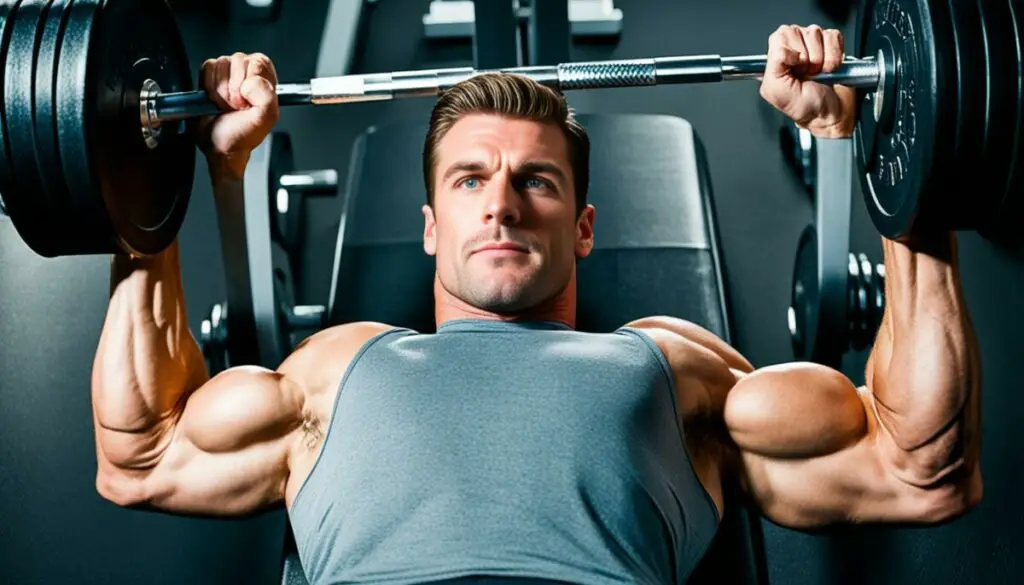
To perform the incline bench press with proper form, it’s important to set the bench angle to around 30 degrees. This angle allows for optimal upper pec activation while minimizing shoulder joint stress. Here are the step-by-step instructions:
- Set the bench angle: Adjust the incline bench to approximately 30 degrees.
- Grip the barbell: Maintain a shoulder-width grip on the barbell.
- Lower the barbell: Slowly lower the barbell until it is about an inch away from your chest.
- Arm position: Keep your arms at a 45-degree angle and tucked into your sides.
- Push the barbell up: Push the barbell back up to the starting position, fully extending your arms and squeezing your chest.
Remember to experiment with grip widths and bar paths to find what feels best for your body and minimizes stress on your shoulder joint. Maintaining proper form during the incline bench press will help prevent injuries and ensure effective upper chest activation.
Touching the Chest in Incline Bench Press
Whether or not you should touch your chest in the incline bench press depends on your individual body structure. If your arms, especially forearms, are long relative to your body, touching your chest may be difficult or even impossible.
The goal of the incline bench press is to work your muscles through a long range of motion and achieve a full stretch of the upper pecs and front deltoids. For many people, this full range of motion is achieved when the barbell touches the chest. However, it’s important to note that this may not be the case for everyone.
If touching the chest in the incline bench press is uncomfortable or not possible for you, don’t worry! There are alternative exercises that can provide a longer range of motion and still activate the upper pecs effectively. One such exercise is the incline dumbbell press. With dumbbells, you can allow your shoulders to move more freely and achieve a greater stretch, which can be more comfortable for individuals with longer arms.
Remember, the aim of the incline bench press is to activate the upper pecs and front deltoids. As long as you are feeling the muscles working and achieving a full stretch, the specific range of motion may vary from person to person. Listen to your body, focus on form, and choose the variation that works best for you.
Tips for Proper Form in Incline Bench Press:
- Set the bench angle to around 30 degrees for optimal upper chest activation.
- Maintain a grip width that is comfortable and allows for proper form.
- Lower the barbell or dumbbells until you achieve a full stretch of the upper pecs and front deltoids.
- Keep your elbows slightly tucked in and your arms at a 45-degree angle to maximize muscle activation.
- Push the weight back up to the starting position, fully extending your arms and squeezing your chest.
Benefits of Touching the Chest:
Touching the chest in the incline bench press allows for a greater range of motion, which can lead to increased upper pec activation and muscle development. The deeper stretch achieved by touching the chest can also help improve flexibility and mobility in the shoulder joint.
Side-By-Side Comparison of Incline Bench Press Variations:
| Exercise | Range of Motion | Upper Pec Activation |
|---|---|---|
| Incline Bench Press (barbell) | Full stretch when barbell touches the chest | High |
| Incline Dumbbell Press | Greater range of motion due to freedom of movement | High |
How Much More to Flat Bench Press vs Incline Bench Press
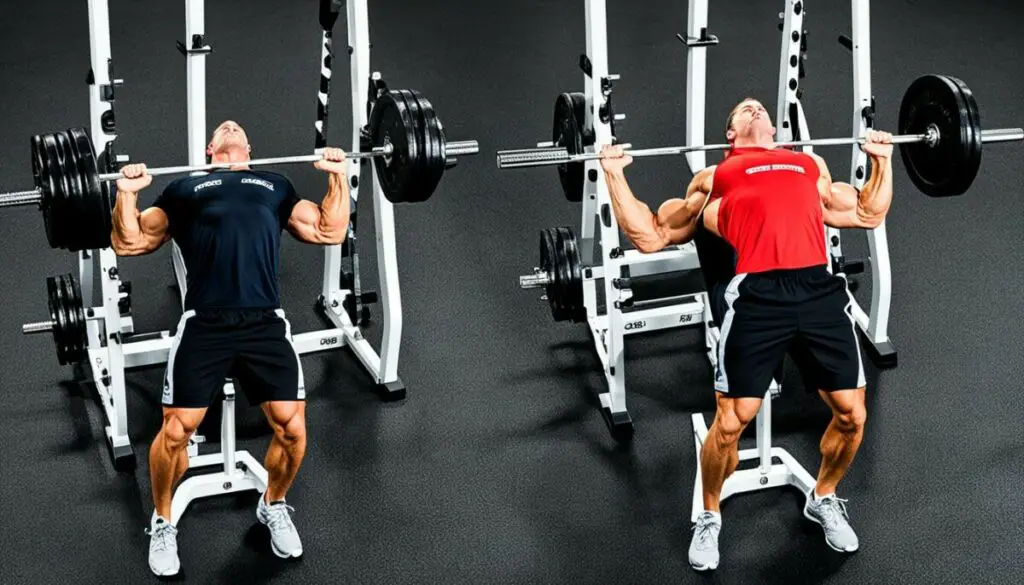
When it comes to comparing the flat bench press and the incline bench press, one question often arises – how much more weight can you lift in the flat bench press compared to the incline bench press?
For most people, the flat bench press allows them to lift 20 to 30% more weight than the incline bench press. This significant difference in strength can be attributed to the more efficient pressing angle in the flat bench press, which allows for better utilization of the chest muscles. The flat bench press primarily targets the middle and lower chest, which are generally stronger than the upper chest worked during the incline bench press.
However, it is important to note that the ideal strength ratio between the flat bench press and the incline bench press will vary depending on individual body structure and strengths. Some individuals may have a more developed upper chest and find the incline bench press to be closer in strength to the flat bench press.
To optimize your overall chest development and strength, it is recommended to train both the flat bench press and the incline bench press equally and consistently. By incorporating both exercises into your workout routine, you can achieve a balanced chest and ensure comprehensive muscle growth.
| Exercise | Strength Ratio |
|---|---|
| Flat Bench Press | 100% |
| Incline Bench Press | 70-80% |
Remember, the percentage values provided in the table are general guidelines and should not be taken as a strict rule. It is essential to focus on your individual body structure and strengths when determining the appropriate strength ratio for you.
When training both the flat bench press and the incline bench press, be sure to maintain proper form, engage the targeted muscles, and gradually increase the weight as your strength improves. By doing so, you can optimize your chest development and build a strong, balanced physique.
Benefits of Incline Bench Press for Shoulder Joint
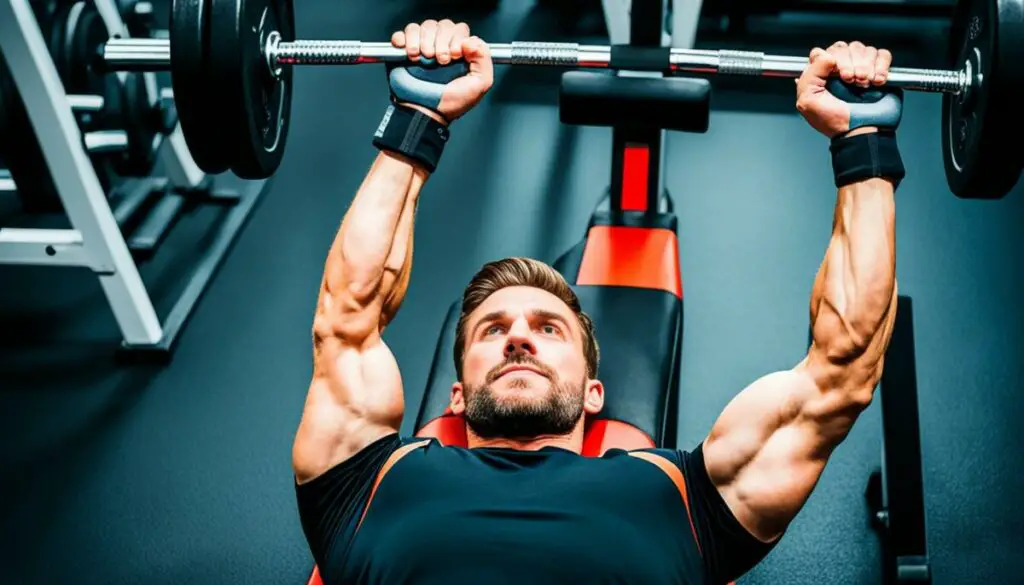
Many people find that the incline bench press places less stress on their shoulder joint compared to the standard flat bench press. This can be beneficial for individuals who experience shoulder pain or discomfort from flat benching but tolerate incline benching well. By switching some of your flat bench press volume for incline presses, you can potentially reduce the risk of shoulder injuries and keep your shoulder joints healthier.
It’s important to experiment with different inclinations, grip widths, and bar paths to find what feels best and most comfortable for your body. By doing so, you can alleviate shoulder joint stress and optimize your shoulder joint health while still reaping the benefits of chest and upper body strength training.
Incline Bench Press vs Flat Bench Press for Chest Development
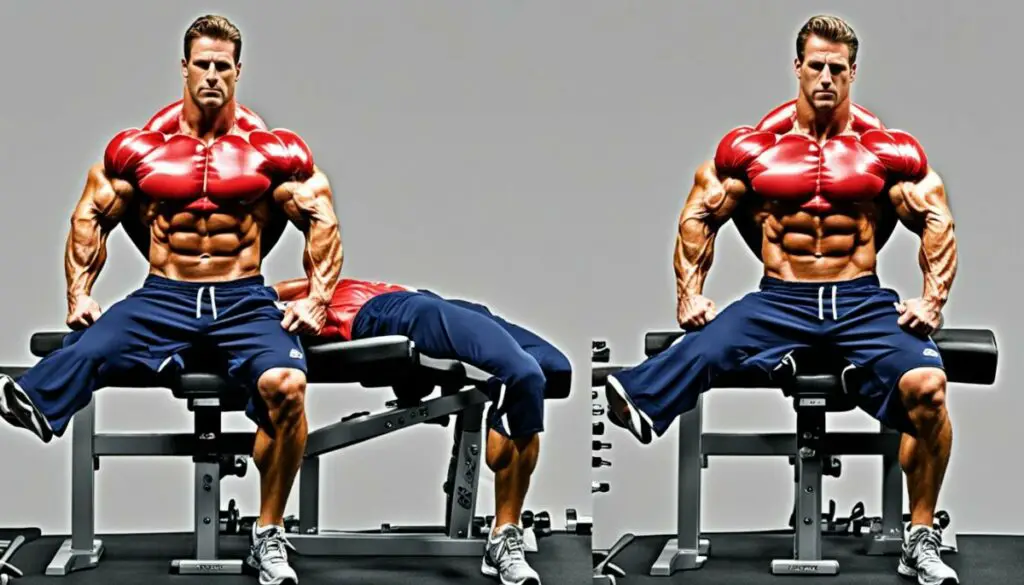
If you can only choose one bench press exercise for chest development, the flat barbell bench press is generally considered the better choice. It works the entire chest, including the upper, middle, and lower pecs, in a longer range of motion. However, if you want to target your upper pecs specifically, incorporating the incline bench press as a secondary exercise can be beneficial. The incline press allows for greater activation of the upper pecs and can complement the overall chest development achieved through the flat bench press. Finding the right balance between the two exercises is key for a well-rounded chest workout.
When comparing the incline bench press and the flat bench press for chest development, it’s important to consider the specific muscle groups targeted and the range of motion utilized.
- The flat bench press: Targets the entire chest, including the upper, middle, and lower pecs.
- The incline bench press: Focuses on the upper pecs and complements overall chest development.
The flat bench press allows for a longer range of motion, engaging the chest muscles through a wider arc. This exercise is effective for overall chest development. On the other hand, the incline bench press places greater emphasis on the upper pecs, aiding in the specific targeting of this muscle group.
To maximize chest development, it is recommended to incorporate both exercises into your workout routine. The flat bench press forms the foundation for overall chest strength and muscle mass, while the incline bench press adds the finishing touch by targeting the upper chest.
Incline Bench Press vs Flat Bench Press: Key Considerations
When determining the ideal incline to flat bench press ratio, it’s essential to consider individual goals, preferences, and body structure. Some factors to consider include:
- Strength development: Most individuals are stronger in the flat bench press compared to the incline bench press. Maintaining a balanced strength ratio between the two exercises is essential for overall chest development.
- Upper chest emphasis: If you desire greater upper chest development, incorporating the incline bench press with an appropriate bench angle is crucial. This exercise targets the upper pecs and can help create a more balanced and aesthetic chest.
- Range of motion: The flat bench press allows for a longer range of motion, engaging the chest muscles through a wider arc. This can contribute to increased muscle recruitment and overall chest development.
- Volume and intensity: Adjusting the volume and intensity of each exercise can help emphasize different areas of the chest. Increasing the volume of incline bench press can provide additional stimulation to the upper pecs, while manipulating the intensity of flat bench press can enhance overall chest strength.
Ultimately, finding the right incline to flat bench press ratio will depend on your specific goals and preferences. It is recommended to consult with a qualified fitness professional to create a tailored workout program that suits your individual needs.
Summary
Both the incline bench press and the flat bench press are valuable exercises for chest development. The flat bench press targets the entire chest and provides a longer range of motion, while the incline bench press emphasizes the upper pecs.
| Exercise | Targeted Muscle Groups |
|---|---|
| Incline Bench Press | Upper Pecs |
| Flat Bench Press | Entire Chest (Upper, Middle, and Lower Pecs) |
To achieve well-rounded chest development, it is recommended to incorporate both exercises into your routine. The incline bench press can be performed as a secondary exercise, focusing on the upper pecs. By finding the right incline to flat bench press ratio and combining proper form, adequate volume, and suitable intensity, you can achieve optimal chest development and create a balanced and aesthetically pleasing physique.
Mistakes to Avoid in Incline Bench Press
Proper form is crucial when performing the incline bench press to maximize upper chest activation and avoid front delt dominance. Here are two common mistakes to avoid:
1. Wrong Bench Angle
One of the most common mistakes in incline bench press is using the wrong bench angle. Research has shown that a 30-degree incline is optimal for targeting the upper chest while minimizing front delt dominance. Setting the bench angle too high or too low can result in suboptimal muscle activation and reduce the effectiveness of the exercise. To ensure proper form and muscle activation, adjust the bench to a 30-degree incline.
2. Improper Should Blade Engagement
Another mistake to avoid is not engaging the shoulder blades properly during the incline bench press. Squeezing the shoulder blades back and down helps to position the chest muscles for optimal contraction and reduces the dominance of the front delts. By actively engaging the shoulder blades throughout the exercise, you can ensure that the chest muscles are properly activated and the front delts are not taking over.
Remember, proper form is key to maximizing upper chest activation in the incline bench press. Focus on setting the bench at a 30-degree incline and engaging the shoulder blades to avoid front delt dominance and achieve optimal results.
How to Perform Incline Bench Press with Proper Form
To effectively perform the incline bench press and maximize upper chest activation, it is crucial to maintain proper form throughout the exercise. Follow these steps to ensure you are executing the incline bench press correctly:
- Set the Bench Angle: Adjust the bench angle to approximately 30 degrees. This angle optimizes upper chest activation while minimizing front deltoid involvement.
- Position Yourself: Sit on the bench with your feet flat on the ground, creating a stable base. Grab a pair of dumbbells, allowing for a comfortable grip.
- Engage Your Shoulders: Before starting the exercise, retract and squeeze your shoulder blades back and down. This engages the upper back muscles and stabilizes the shoulder joints.
- Execute the Repetitions: With the dumbbells at shoulder level, press them up using the power of your chest muscles. Focus on a controlled movement and a full range of motion. Feel the contraction in your upper chest as you lift the weight.
- Lower the Dumbbells: Lower the dumbbells back to the starting position, maintaining control and avoiding any bouncing or jerking motions.
- Mind to Muscle Connection: Throughout the exercise, concentrate on establishing a strong mind-to-muscle connection with your upper chest. Visualize your chest muscles working and contracting with each repetition.
By following these steps and maintaining proper form, you can ensure effective upper chest activation and maximize the benefits of the incline bench press.
Expert Tip:
“Remember to start with a weight that allows you to maintain proper form and gradually increase the load as you become more comfortable and stronger. Form and technique should always take precedence over the amount of weight lifted.”
Conclusion
Optimizing the incline to flat bench ratio in your workout routine is essential for achieving optimal chest development and maximizing your strength training results. By incorporating both incline and flat bench presses, you can effectively target different areas of your chest while also engaging your shoulders and triceps.
When performing the incline bench press, finding the right bench angle is crucial. A 30-degree incline is generally recommended to activate the upper chest muscles effectively. Additionally, remember to engage your shoulder blades properly to minimize front delt dominance and ensure optimal muscle activation.
Listening to your body and experimenting with different techniques is key to discovering the ideal incline to flat bench ratio that works best for you. Adjust the ratio based on your individual goals and preferences, and strive for a well-balanced approach that allows you to optimize your lifts and achieve significant muscle growth in your chest.
Remember, consistency and proper form are vital in your strength training journey. Keep pushing yourself, mastering the correct techniques, and maintaining a well-rounded workout routine that includes the incline bench press, flat bench press, and other chest exercises. With dedication and perseverance, you can accomplish your chest development and strength training goals.
FAQ
What are the differences between the incline and flat bench presses?
The incline bench press targets the upper chest more than the flat bench press, while the flat bench press works the entire chest. The incline bench press also activates the anterior deltoids (front delts) to a greater extent.
What is the best angle for incline bench pressing?
The best angle for incline bench pressing is around 30 degrees. This angle provides significantly higher upper pec activation compared to the middle and lower pec.
How does the incline bench press improve the flat bench press?
The incline bench press targets the upper chest and anterior deltoids more, which can contribute to increased overall chest muscle development and strength in exercises that use these muscles.
What is the proper form for the incline bench press?
To perform the incline bench press with proper form, set the bench angle to around 30 degrees. Maintain a shoulder-width grip on the barbell, lower it until it is about an inch away from your chest, and push it back up to the starting position.
Should I touch my chest in the incline bench press?
Whether or not you should touch your chest in the incline bench press depends on your individual body structure. The goal is to work your muscles through a long range of motion and achieve a full stretch of the upper pecs and front deltoids.
How much stronger are most people in the flat bench press compared to the incline bench press?
Most people are 20 to 30% stronger in the flat bench press compared to the incline bench press.
What are the benefits of the incline bench press for the shoulder joint?
Many people find that the incline bench press places less stress on their shoulder joint compared to the standard flat bench press. By switching some of your flat bench press volume for incline presses, you can potentially reduce the risk of shoulder injuries and keep your shoulder joints healthier.
Which is better for chest development, the incline bench press or the flat bench press?
If you can only choose one bench press exercise for chest development, the flat barbell bench press is generally considered the better choice as it works the entire chest. However, incorporating the incline bench press as a secondary exercise can be beneficial for targeting the upper pecs specifically.
What are the common mistakes to avoid in the incline bench press?
The common mistakes to avoid in the incline bench press are using the wrong bench angle and not engaging the shoulder blades properly. Setting the bench angle too high or too low can result in suboptimal muscle activation, and not squeezing the shoulder blades back and down can reduce the contraction of the chest muscles.
How do I perform the incline bench press with proper form?
To perform the incline bench press with proper form, set the bench angle to around 30 degrees, grab a pair of dumbbells, engage your shoulder blades by squeezing them back and down, and press the dumbbells up from your chest to a full range of motion.
How do I optimize the incline to flat bench ratio in my workout routine?
Optimizing the incline to flat bench ratio in your workout routine is important for chest development and overall strength training. Incorporate both exercises, experiment with different techniques, and adjust the ratio based on your individual goals and preferences.



